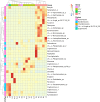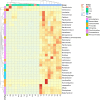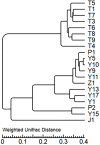High-throughput sequencing of microbial community diversity in soil, grapes, leaves, grape juice and wine of grapevine from China
- PMID: 29565999
- PMCID: PMC5863948
- DOI: 10.1371/journal.pone.0193097
High-throughput sequencing of microbial community diversity in soil, grapes, leaves, grape juice and wine of grapevine from China
Abstract
In this study Illumina MiSeq was performed to investigate microbial diversity in soil, leaves, grape, grape juice and wine. A total of 1,043,102 fungal Internal Transcribed Spacer (ITS) reads and 2,422,188 high quality bacterial 16S rDNA sequences were used for taxonomic classification, revealed five fungal and eight bacterial phyla. At the genus level, the dominant fungi were Ascomycota, Sordariales, Tetracladium and Geomyces in soil, Aureobasidium and Pleosporaceae in grapes leaves, Aureobasidium in grape and grape juice. The dominant bacteria were Kaistobacter, Arthrobacter, Skermanella and Sphingomonas in soil, Pseudomonas, Acinetobacter and Kaistobacter in grape and grapes leaves, and Oenococcus in grape juice and wine. Principal coordinate analysis showed structural separation between the composition of fungi and bacteria in all samples. This is the first study to understand microbiome population in soil, grape, grapes leaves, grape juice and wine in Xinjiang through High-throughput Sequencing and identify microorganisms like Saccharomyces cerevisiae and Oenococcus spp. that may contribute to the quality and flavor of wine.
Conflict of interest statement
Figures









Similar articles
-
The microbial ecology of wine grape berries.Int J Food Microbiol. 2012 Feb 15;153(3):243-59. doi: 10.1016/j.ijfoodmicro.2011.11.025. Epub 2011 Dec 2. Int J Food Microbiol. 2012. PMID: 22189021
-
Microbial community composition on grape surface controlled by geographical factors of different wine regions in Xinjiang, China.Food Res Int. 2019 Aug;122:348-360. doi: 10.1016/j.foodres.2019.04.029. Epub 2019 Apr 17. Food Res Int. 2019. PMID: 31229088
-
Analysis of Microbial Community Diversity on the Epidermis of Wine Grapes in Manasi's Vineyard, Xinjiang.Foods. 2022 Oct 12;11(20):3174. doi: 10.3390/foods11203174. Foods. 2022. PMID: 37430923 Free PMC article.
-
Oenococcus oeni and the genomic era.FEMS Microbiol Rev. 2017 Aug 1;41(Supp_1):S84-S94. doi: 10.1093/femsre/fux034. FEMS Microbiol Rev. 2017. PMID: 28830095 Review.
-
Fungi and mycotoxins in vineyards and grape products.Int J Food Microbiol. 2007 Oct 20;119(1-2):84-8. doi: 10.1016/j.ijfoodmicro.2007.07.031. Epub 2007 Aug 9. Int J Food Microbiol. 2007. PMID: 17765989 Review.
Cited by
-
Carbendazim Modulates the Metabolically Active Bacterial Populations in Soil and Rhizosphere.Curr Microbiol. 2023 Jul 13;80(9):280. doi: 10.1007/s00284-023-03391-0. Curr Microbiol. 2023. PMID: 37439951
-
High-Throughput Sequencing-Based Analysis of Rhizosphere and Diazotrophic Bacterial Diversity Among Wild Progenitor and Closely Related Species of Sugarcane (Saccharum spp. Inter-Specific Hybrids).Front Plant Sci. 2022 Feb 24;13:829337. doi: 10.3389/fpls.2022.829337. eCollection 2022. Front Plant Sci. 2022. PMID: 35283913 Free PMC article.
-
A global microbiome survey of vineyard soils highlights the microbial dimension of viticultural terroirs.Commun Biol. 2022 Mar 18;5(1):241. doi: 10.1038/s42003-022-03202-5. Commun Biol. 2022. PMID: 35304890 Free PMC article.
-
Analysis of Phyllosphere Microorganisms and Potential Pathogens of Tobacco Leaves.Front Microbiol. 2022 Apr 29;13:843389. doi: 10.3389/fmicb.2022.843389. eCollection 2022. Front Microbiol. 2022. PMID: 35572673 Free PMC article.
-
Year, Location, and Variety Impact on Grape-Associated Mycobiota of Arkansas-Grown Wine Grapes for Wine Production.Microb Ecol. 2021 Nov;82(4):845-858. doi: 10.1007/s00248-021-01705-y. Epub 2021 Mar 5. Microb Ecol. 2021. PMID: 33665722
References
-
- Zarraonaindia I, Owens SM, Weisenhorn P, West K, Hampton-Marcell J, Lax S, et al. The soil microbiome influences grapevine-associated microbiota. mBio 2015, 6: e02527–14. doi: 10.1128/mBio.02527-14 - DOI - PMC - PubMed
-
- Barata A, Malfeito-Ferreira M, Loureiro V. The microbial ecology of wine grape berries. Int. J. Food Microbiol. 2012, 153(3): 243–259. - PubMed
-
- Swiegers JH, Bartowsky EJ, Henschke PA, Pretorius IS. Yeast and bacterial modulation of wine aroma and flavor. Aust J Grape Wine Res. 2010,11(2): 139–173.
-
- Leonetti D, Soleti R, Clere N, Vergori L, Jacques C, Duluc L, et al. Estrogen receptor α participates to the beneficial effect of red wine polyphenols in a mouse model of obesity-related disorders. Front Pharmacol. 2016,7:529 doi: 10.3389/fphar.2016.00529 - DOI - PMC - PubMed
-
- Estruch R, Ros E, Salas-Salvadó J, Covas MI, Corella D, Arós F, et al. Primary prevention of cardiovascular disease with a Mediterranean Diet. N Engl J Med. 2013,368(14):1279–1290. doi: 10.1056/NEJMoa1200303 - DOI - PubMed
Publication types
MeSH terms
LinkOut - more resources
Full Text Sources
Other Literature Sources
Miscellaneous

